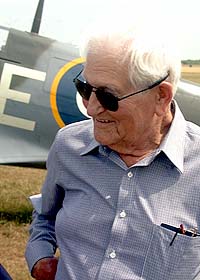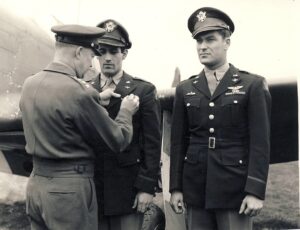 I suppose someone had to be the one…the fighter who carried out the most missions of the war. For one thing he would be the one who was fortunate enough to survive all those missions, and he would have to be the one who didn’t just go home when he finished the required number of missions to be discharged from service. For World War II, that man was Donald James Matthew Blakeslee, who was an officer in the United States Air Force. His aviation career commenced as a pilot in the Royal Canadian Air Force, flying Spitfire aircraft during World War II. Then, he joined the Air Force Eagle Squadrons, before transferring to the United States Army Air Forces in 1942. He flew more combat missions against the Luftwaffe than any other American fighter pilot, and by end of the war, he was a triple flying ace credited with 15.5 aerial victories.
I suppose someone had to be the one…the fighter who carried out the most missions of the war. For one thing he would be the one who was fortunate enough to survive all those missions, and he would have to be the one who didn’t just go home when he finished the required number of missions to be discharged from service. For World War II, that man was Donald James Matthew Blakeslee, who was an officer in the United States Air Force. His aviation career commenced as a pilot in the Royal Canadian Air Force, flying Spitfire aircraft during World War II. Then, he joined the Air Force Eagle Squadrons, before transferring to the United States Army Air Forces in 1942. He flew more combat missions against the Luftwaffe than any other American fighter pilot, and by end of the war, he was a triple flying ace credited with 15.5 aerial victories.
Blakeslee was born in Fairport Harbor, Ohio, on September 11, 1917. He developed an interest in flying early in life after observing the Cleveland Air Races as a boy. With money saved from his job the Diamond Alkali Company, he and a friend purchased a Piper J-3 in the mid-1930s and flew it from Willoughby Field, Ohio. However, his friend crashed the plane in 1940, prompting Blakeslee to decide that the best way to continue flying was to join the Royal Canadian Air Force (RCAF).
Blakeslee was trained in Canada and then sent to England on May 15, 1941. There, he was assigned to Number 401 Squadron CAF, which was part of the Biggin Hill Wing. Pilot Officer Blakeslee first saw combat on November 18, 1941, flying sweeps, when he damaged a BF-109 near Le Touquet. He claimed his first kill on November 22, 1941, a BF-109 over Desvres, about 10 miles south of Marck. On the same mission he damaged another BF-109 while returning to base. His next kills were claimed on April 28, 1942, probably destroying two FW190s. Although not a particularly good shot, he was receptive to the principles of air fighting tactics and soon proved to be a leader, both in the air and on the ground.
By the summer of 1942, he an acting flight lieutenant and was awarded the British Distinguished Flying Cross on August 14, 1942. The presentation stated that “Acting Flight Lieutenant Donald Mathew BLAKESLEE (Can.J/4551), Royal Canadian Air Force. 133 (E) Squadron. This officer has completed a large number of sorties over enemy territory. He has destroyed one, destroyed, and damaged several more hostile aircraft. He is a fine whose keenness has proved most inspiring. He then completed his first tour of duty, clocking 200 combat hours with three victories.”
Blakeslee never wanted to join the American volunteer Eagle Squadrons, because he claimed that “they exaggerated their claims.” However, when informed he was to be assigned as an instructor pilot, he volunteered to be sent to Number 133 (Eagle) RAF as its commanding officer. It was the only way to maintain his combat status. During raid Dieppe, France on August 18, 1942, Blakeslee shot down additional FW-190 and probably destroyed another on the 19th, thus achieving his first ace status. Blakeslee would go on to achieve ace status twice more, but that was not the only claim to fame he would have to his name.
On September 12, 1942, the 71st, 121st, and 133rd Squadrons were activated as the USAAF’s 4 Group,  operating from a former RAF field at Debden. After a few months of flying Spitfires, the group was re-equipped with the new Republic P-47 Thunderbolt. On April 15, 1943, Blakeslee claimed an FW-190 for the group’s first P-47 kill and claimed another FW-190 on May 14, 1943, both near Knocke. Leading the 335th Squadron of the 4th Fighter Group, Blakeslee led the group into Germany the first time on July 28. Towards the end of the year, Blakeslee led the group more often and developed a tactic of circling above any air battle and so he could better direct his fighters.
operating from a former RAF field at Debden. After a few months of flying Spitfires, the group was re-equipped with the new Republic P-47 Thunderbolt. On April 15, 1943, Blakeslee claimed an FW-190 for the group’s first P-47 kill and claimed another FW-190 on May 14, 1943, both near Knocke. Leading the 335th Squadron of the 4th Fighter Group, Blakeslee led the group into Germany the first time on July 28. Towards the end of the year, Blakeslee led the group more often and developed a tactic of circling above any air battle and so he could better direct his fighters.
Blakes first flew the P-51 Mustang in December 1943 and subsequently worked diligently to have the 4th Fighter Group re-equipped with the new aircraft as soon as possible, especially after assuming command of the 4th Fighter Group on January 1, 1944. The 8th Air Force Command eventually granted the request, stipulating that the pilots must be on the P-51 within 24 hours of receiving them. Blakeslee agreed, instructing his pilots to “learn how to fly them on the way the target.”
Blakeslee piloted the first Mustang over Berlin on March 6, 1944, defending Boeing B-17s and Consolidated B24s. The 4th Fighter Group, under Blakeslee’s command, escorted the mass daylight raids of the 8th Air Force over Occupied Europe and became one of the highest-scoring groups of VIII Fighter Command. The 4th’s aggressive tactics under Blakeslee proved effective, and they surpassed the 500-kill mark by the end of April 1944. By the end of the war, the group had destroyed 1,020 German planes (550 in flight and 470 on the ground). The next landmark for Blakeslee was leading the first “shuttle” mission to Russia on June 21, 1944, flying 1,470 miles in a mission lasting over 7 hours.
In September of 1944, Don Blakeslee was finally grounded following the loss of several high-scoring USAAF aces. He had achieved 15 kills in the air two more on the ground. He had flown 500 operational sorties and accumulated 1,000 hours. Barrett Tillman, who served as an executive secretary the American Fighter Aces Association, stated that Blakeslee had more missions and hours “than any other American fighter pilot of World War II.” Blakeslee retired from the United States Force in 1965 with the rank of colonel. In his obituary in The Guardian, Blakeslee was described as “the most decorated Second World War US Air Force fighter pilot.” Blakeslee’s personal standing among Allied pilots was considerable. British ace Johnnie Johnson described him as “one of the best leaders ever to fight over Germany.”
Following the conclusion of World War II, Blakeslee continued his service in the newly established United States Air Force. During the Korean War, he commanded the 27th Fighter-Escort Group at Taegu Air Base in South Korea and Itazuke Air Base in Japan, flying several missions in the F-84 Thunderjet from December 1950 to  March 1951. In March 1963, he was promoted to colonel, and his final assignment was as Special Assistant to the Director of Operations for the Seventeenth Air Force, serving from 1964 until his retirement on April 30, 1965. After retiring, Blakeslee lived in Miami, Florida. He married Leola Fryer in 1944 and had one daughter. She passed away in 2005. Blakeslee died on September 3, 2008, at his home due to heart failure. On Friday September 18, 2008, Colonel Don Blakeslee and his wife’s ashes were interred at Arlington National Cemetery. The ceremony took place at 1100 hours and was open to the public. The 4th Fighter Wing also did a flyover at the ceremony.
March 1951. In March 1963, he was promoted to colonel, and his final assignment was as Special Assistant to the Director of Operations for the Seventeenth Air Force, serving from 1964 until his retirement on April 30, 1965. After retiring, Blakeslee lived in Miami, Florida. He married Leola Fryer in 1944 and had one daughter. She passed away in 2005. Blakeslee died on September 3, 2008, at his home due to heart failure. On Friday September 18, 2008, Colonel Don Blakeslee and his wife’s ashes were interred at Arlington National Cemetery. The ceremony took place at 1100 hours and was open to the public. The 4th Fighter Wing also did a flyover at the ceremony.


Leave a Reply